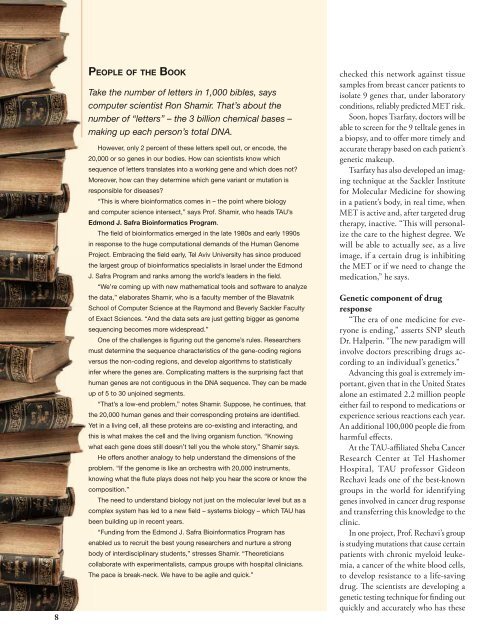Personalized Medicine “It doesn't get more personal than this.â€
Personalized Medicine “It doesn't get more personal than this.â€
Personalized Medicine “It doesn't get more personal than this.â€
You also want an ePaper? Increase the reach of your titles
YUMPU automatically turns print PDFs into web optimized ePapers that Google loves.
8<br />
peopLe of the Book<br />
Take the number of letters in 1,000 bibles, says<br />
computer scientist Ron Shamir. That’s about the<br />
number of “letters” – the 3 billion chemical bases –<br />
making up each person’s total DNA.<br />
However, only 2 percent of these letters spell out, or encode, the<br />
20,000 or so genes in our bodies. How can scientists know which<br />
sequence of letters translates into a working gene and which does not?<br />
Moreover, how can they determine which gene variant or mutation is<br />
responsible for diseases?<br />
“This is where bioinformatics comes in – the point where biology<br />
and computer science intersect,” says Prof. Shamir, who heads TAU’s<br />
Edmond J. Safra Bioinformatics Program.<br />
The field of bioinformatics emerged in the late 1980s and early 1990s<br />
in response to the huge computational demands of the Human Genome<br />
Project. Embracing the field early, Tel Aviv University has since produced<br />
the largest group of bioinformatics specialists in Israel under the Edmond<br />
J. Safra Program and ranks among the world’s leaders in the field.<br />
“We’re coming up with new mathematical tools and software to analyze<br />
the data,” elaborates Shamir, who is a faculty member of the Blavatnik<br />
School of Computer Science at the Raymond and Beverly Sackler Faculty<br />
of Exact Sciences. “And the data sets are just <strong>get</strong>ting bigger as genome<br />
sequencing becomes <strong>more</strong> widespread.”<br />
One of the challenges is figuring out the genome’s rules. Researchers<br />
must determine the sequence characteristics of the gene-coding regions<br />
versus the non-coding regions, and develop algorithms to statistically<br />
infer where the genes are. Complicating matters is the surprising fact that<br />
human genes are not contiguous in the DNA sequence. They can be made<br />
up of 5 to 30 unjoined segments.<br />
“That’s a low-end problem,” notes Shamir. Suppose, he continues, that<br />
the 20,000 human genes and their corresponding proteins are identified.<br />
Yet in a living cell, all these proteins are co-existing and interacting, and<br />
<strong>this</strong> is what makes the cell and the living organism function. “Knowing<br />
what each gene does still doesn’t tell you the whole story,” Shamir says.<br />
He offers another analogy to help understand the dimensions of the<br />
problem. “If the genome is like an orchestra with 20,000 instruments,<br />
knowing what the flute plays does not help you hear the score or know the<br />
composition.”<br />
The need to understand biology not just on the molecular level but as a<br />
complex system has led to a new field – systems biology – which TAU has<br />
been building up in recent years.<br />
“Funding from the Edmond J. Safra Bioinformatics Program has<br />
enabled us to recruit the best young researchers and nurture a strong<br />
body of interdisciplinary students,” stresses Shamir. “Theoreticians<br />
collaborate with experimentalists, campus groups with hospital clinicians.<br />
The pace is break-neck. We have to be agile and quick.”<br />
checked <strong>this</strong> network against tissue<br />
samples from breast cancer patients to<br />
isolate 9 genes that, under laboratory<br />
conditions, reliably predicted MET risk.<br />
Soon, hopes Tsarfaty, doctors will be<br />
able to screen for the 9 telltale genes in<br />
a biopsy, and to offer <strong>more</strong> timely and<br />
accurate therapy based on each patient’s<br />
genetic makeup.<br />
Tsarfaty has also developed an imaging<br />
technique at the Sackler Institute<br />
for Molecular <strong>Medicine</strong> for showing<br />
in a patient’s body, in real time, when<br />
MET is active and, after tar<strong>get</strong>ed drug<br />
therapy, inactive. “This will <strong>personal</strong>ize<br />
the care to the highest degree. We<br />
will be able to actually see, as a live<br />
image, if a certain drug is inhibiting<br />
the MET or if we need to change the<br />
medication,” he says.<br />
Genetic component of drug<br />
response<br />
“The era of one medicine for everyone<br />
is ending,” asserts SNP sleuth<br />
Dr. Halperin. “The new paradigm will<br />
involve doctors prescribing drugs according<br />
to an individual’s genetics.”<br />
Advancing <strong>this</strong> goal is extremely important,<br />
given that in the United States<br />
alone an estimated 2.2 million people<br />
either fail to respond to medications or<br />
experience serious reactions each year.<br />
An additional 100,000 people die from<br />
harmful effects.<br />
At the TAU-affiliated Sheba Cancer<br />
Research Center at Tel Hashomer<br />
Hospital, TAU professor Gideon<br />
Rechavi leads one of the best-known<br />
groups in the world for identifying<br />
genes involved in cancer drug response<br />
and transferring <strong>this</strong> knowledge to the<br />
clinic.<br />
In one project, Prof. Rechavi’s group<br />
is studying mutations that cause certain<br />
patients with chronic myeloid leukemia,<br />
a cancer of the white blood cells,<br />
to develop resistance to a life-saving<br />
drug. The scientists are developing a<br />
genetic testing technique for finding out<br />
quickly and accurately who has these

















